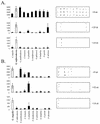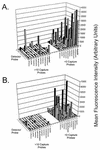Sequence versus structure for the direct detection of 16S rRNA on planar oligonucleotide microarrays
- PMID: 12732571
- PMCID: PMC154527
- DOI: 10.1128/AEM.69.5.2950-2958.2003
Sequence versus structure for the direct detection of 16S rRNA on planar oligonucleotide microarrays
Abstract
A two-probe proximal chaperone detection system consisting of a species-specific capture probe for the microarray and a labeled, proximal chaperone probe for detection was recently described for direct detection of intact rRNAs from environmental samples on oligonucleotide arrays. In this study, we investigated the physical spacing and nucleotide mismatch tolerance between capture and proximal chaperone detector probes that are required to achieve species-specific 16S rRNA detection for the dissimilatory metal and sulfate reducer 16S rRNAs. Microarray specificity was deduced by analyzing signal intensities across replicate microarrays with a statistical analysis-of-variance model that accommodates well-to-well and slide-to-slide variations in microarray signal intensity. Chaperone detector probes located in immediate proximity to the capture probe resulted in detectable, nonspecific binding of nontarget rRNA, presumably due to base-stacking effects. Species-specific rRNA detection was achieved by using a 22-nt capture probe and a 15-nt detector probe separated by 10 to 14 nt along the primary sequence. Chaperone detector probes with up to three mismatched nucleotides still resulted in species-specific capture of 16S rRNAs. There was no obvious relationship between position or number of mismatches and within- or between-genus hybridization specificity. From these results, we conclude that relieving secondary structure is of principal concern for the successful capture and detection of 16S rRNAs on planar surfaces but that the sequence of the capture probe is more important than relieving secondary structure for achieving specific hybridization.
Figures




Similar articles
-
Direct detection of 16S rRNA in soil extracts by using oligonucleotide microarrays.Appl Environ Microbiol. 2001 Oct;67(10):4708-16. doi: 10.1128/AEM.67.10.4708-4716.2001. Appl Environ Microbiol. 2001. PMID: 11571176 Free PMC article.
-
Specific multiplex analysis of pathogens using a direct 16S rRNA hybridization in microarray system.Anal Chem. 2012 Jun 5;84(11):4873-9. doi: 10.1021/ac300476k. Epub 2012 May 11. Anal Chem. 2012. PMID: 22551354
-
Monitoring the enrichment and isolation of sulfate-reducing bacteria by using oligonucleotide hybridization probes designed from environmentally derived 16S rRNA sequences.Appl Environ Microbiol. 1993 Mar;59(3):682-6. doi: 10.1128/aem.59.3.682-686.1993. Appl Environ Microbiol. 1993. PMID: 7683181 Free PMC article.
-
Label-free detection of 16S ribosomal RNA hybridization on reusable DNA arrays using surface plasmon resonance imaging.Environ Microbiol. 2002 Nov;4(11):735-43. doi: 10.1046/j.1462-2920.2002.00350.x. Environ Microbiol. 2002. PMID: 12460281
-
Advances towards integrated biodetection systems for environmental molecular microbiology.Curr Issues Mol Biol. 2002 Jan;4(1):19-32. Curr Issues Mol Biol. 2002. PMID: 11838944 Review.
Cited by
-
Influence of dangling ends and surface-proximal tails of targets on probe-target duplex formation in 16S rRNA gene-based diagnostic arrays.Appl Environ Microbiol. 2007 Jan;73(2):380-9. doi: 10.1128/AEM.01785-06. Epub 2006 Nov 17. Appl Environ Microbiol. 2007. PMID: 17114322 Free PMC article.
-
In situ-synthesized virulence and marker gene biochip for detection of bacterial pathogens in water.Appl Environ Microbiol. 2008 Apr;74(7):2200-9. doi: 10.1128/AEM.01962-07. Epub 2008 Feb 1. Appl Environ Microbiol. 2008. PMID: 18245235 Free PMC article.
-
Robust sequence selection method used to develop the FluChip diagnostic microarray for influenza virus.J Clin Microbiol. 2006 Aug;44(8):2857-62. doi: 10.1128/JCM.00135-06. J Clin Microbiol. 2006. PMID: 16891503 Free PMC article.
-
Development of a rapid assay for determining the relative abundance of bacteria.Appl Environ Microbiol. 2005 Dec;71(12):8481-90. doi: 10.1128/AEM.71.12.8481-8490.2005. Appl Environ Microbiol. 2005. PMID: 16332838 Free PMC article.
-
Operating Cooperatively (OC) sensor for highly specific recognition of nucleic acids.PLoS One. 2013;8(2):e55919. doi: 10.1371/journal.pone.0055919. Epub 2013 Feb 18. PLoS One. 2013. PMID: 23441157 Free PMC article.
References
-
- Amann, R. I. 1995. Fluorescently labelled, rRNA-targeted oligonucleotide probes in the study of microbial ecology. Mol. Ecol. 4:543-554.
-
- Ausubel, F. M., R. Brent, R. E. Kingston, D. D. Moore, J. G. Seidman, J. A. Smith, and K. Struhl (ed.). 1995. Current protocols in molecular biology. John Wiley & Sons, Inc., New York, N.Y.
-
- Beattie, W. G., L. Meng, S. L. Turner, R. S. Varma, D. D. Dao, and K. L. Beattie. 1995. Hybridization of DNA targets to glass-tethered oligonucleotide probes. Mol. Biotechnol. 4:213-225. - PubMed
Publication types
MeSH terms
Substances
LinkOut - more resources
Full Text Sources
Other Literature Sources
Research Materials

